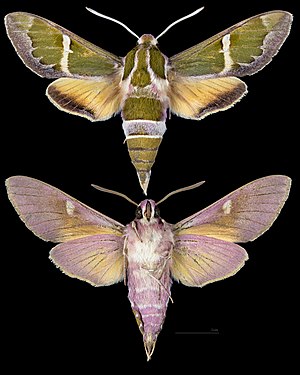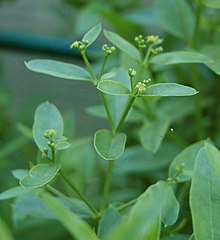Rethera komarovi
| Rethera komarovi | ||||||||||||
|---|---|---|---|---|---|---|---|---|---|---|---|---|

Rethera komarovi , male |
||||||||||||
| Systematics | ||||||||||||
|
||||||||||||
| Scientific name | ||||||||||||
| Rethera komarovi | ||||||||||||
| ( Christoph , 1885) |
Rethera komarovi is a butterfly ( moth ) from the family of moth (Sphingidae). The species is distributed from south-east Europe to south-central Asia and mainly inhabits vegetation islands in rugged, mountainous locations. In the last stage, the caterpillars show a remarkable defense behavior. Due to their perfectly matched color and body shape, they can imitate the defensive movements of a small snake in order to put predators to flight. This is achieved in particular by their large eye spots on the thickened front end of the body, which forms the "snake head".
features
Characteristics of the adults
The moths of the nominate subspecies reach wingspans of 55 to 65 millimeters, the subspecies R. k. manifica is significantly larger with spans of 65 to 81 millimeters. The moths are predominantly brown to olive green on the upper side of the body including the forewings. The forewings have a lighter outer and inner edge as well as a distinctive light-colored band that runs across the center of the wings. In particular, on the wing edges and on the underside of the body, the moths are pale orange to deep pink; the color is otherwise only slightly variable. Freshly hatched specimens have a bright pink tint. The hind wings are light, only their outer edge is brown. The dark color of the upper side of the body increasingly fades with strong sunlight; Animals from hot, sunny regions are therefore usually pale in color. This effect also occurs when the animals are killed with the chemicals diethyl ether or ethyl acetate most commonly used for preparation. The individual dark spots and lines on the forewings are also less strongly developed in individuals from sunnier habitats than in those from less sunny regions.
The subspecies R. k. manifica apart from their size Nominatunterart very similar, but has a much paler color with a less strongly pronounced pattern.
Characteristics of the caterpillars
The nominate form caterpillars are 70 to 90 millimeters long, in R. k. manifica it is 80 to 100 millimeters. The caterpillars of the two subspecies do not differ in terms of color. After hatching, the approximately four millimeter long caterpillars are bluish-yellow and have a small, erect, black anal horn . Their belly legs and the pusher are black, the relatively large head capsule is brown. The first body segments are also larger than the rest. The body bears longitudinal rows of dark, bristle-covered tubercles. As they eat the food plants, the animals gradually turn blue-green and a light longitudinal line forms on both sides of the back. In the second and third instar, the animals are blue-green and have a cylindrical body shape. The caterpillars appear as if they were covered with frost due to very fine white dots, each with a short white bristle . These dots cover the entire body, including the anal horn. The light longitudinal lines are now brightly colored white and range from the now green head capsule to the now reddish, short and straight anal horn. After the subsequent molt, the appearance of the animals changes significantly. The body is now spotted dark and light brown, the anal horn is reduced to a small hump. The head capsule is brown and has three fine, dark longitudinal lines. The spiracles on the first through eighth abdominal segments are designed as eye spots ; they are surrounded by purple and yellow and in turn surrounded by a black spot. In the last stage of the caterpillar, the third thoracic and first abdominal segments are somewhat thickened, which makes the animals resemble a small snake with their large anterior eye-spots.
Similar species
The species can be confused with the other three species of the genus Rethera , Rethera afghanistana , Rethera amseli and Rethera brandti , but it is significantly larger than these.
Occurrence and habitat
The species is distributed disjointly from south-east Europe to south-central Asia. In the west there is an isolated population, the range of which includes the mountainous region of eastern Albania , the south of the former Yugoslavia , the north of Greece and the south of Bulgaria . The wider distribution extends to the west, the center, the south and east of Turkey , Lebanon , the north of Jordan , Armenia , Transcaucasia , the north of Iraq and Iran , the south of Turkmenistan and Uzbekistan , the south and east of Kazakhstan to Tajikistan and Kyrgyzstan . The species can also be found in the Chinese part of the Pamir and Tian-Shan . The species is usually rare, but there are also areas, such as areas in Kurdistan between 1000 and 2000 meters above sea level, where it occurs locally in high density. The two subspecies have an overlapping distribution in the Iraqi area of Kurdistan, R. k. manifica is also found south to the Zāgros Mountains in Iran and in eastern Afghanistan .
The nominate form colonizes vegetation islands in mountainous and hilly terrain on otherwise weakly overgrown slopes and rock faces, which are exposed to the cold in winter and strong heat in summer. In Turkey they can also be found on semi-arid slopes with herbaceous vegetation and on dry river beds lined with vegetation at altitudes between 600 and 1600 meters. R. k. manifica lives in well-defined areas in lush vegetation. They can be found in the mountains between 1500 and 2000 meters above sea level on steep slopes overgrown with grass and herbaceous plants. In particular, slopes dotted with boulders and grazed by cattle are preferred.
Way of life

Almost nothing is known about the way of life of the adults . They are strongly attracted at night by various artificial light sources. During the day they usually rest on the base of low plants, on rocks or directly on the ground in a shady place.
Flight and caterpillar times
The moths of the nominate form fly in one generation from mid-April to mid-June, depending on the distribution area. In Turkey, the species flies from the beginning of April / May to the end of June, at altitudes over 1500 meters in July. In Kazakhstan , they fly in the mountains east of Almaty from late May to early June. R. k. manifica flies in the last two weeks of May as well as in an incomplete second generation in mid-August. The caterpillars of the nominate form are found from May to June / July, those of R. k. manifica in two generations from May to mid-June and in September.
Food of the caterpillars
The caterpillars of both subspecies feed on red dye ( Rubia ) and bedstraws ( Galium ), whereby R. k. manifica can be found predominantly on blushes. In Armenia the species was found on Rubia rigidifolia .
development
The eggs are 1.6 by 1.4 millimeters in size and slightly oval. At first they are shiny blue-green and have a weak, not quite complete, light line that goes around the egg, which turns brown after a few days. Shortly before hatching, the eggs are grayish. They are placed individually on the top and bottom of the leaves, on stems and buds, and on dry parts of the food plants. A total of up to five eggs are laid per plant. They are preferably deposited on small plants that have been eaten away by cattle and are sprouting at the base, growing close together on the ground or between stones. Plants that grow up on bushes are chosen less often.
After hatching, the caterpillars do not eat their eggshells, but start eating the food plant, especially its buds. In the second and third stage, the caterpillars eat sitting relatively open on the plants, both during the day and at night. They eat buds and also leaves and are well camouflaged by their color. In case of danger, they drop to the base of the plants to hide. In the next stage, the animals only eat at night and hide during the day at the base of the plants between stones and parts of plants. In the last stage, the caterpillars have to climb onto the food plants two to three times a day to meet their large food needs. Your defensive behavior is particularly impressive. When threatened, the caterpillars pull their head and the first two thorax segments into the third thorax segment and the first abdomen segment and raise the front part of the body. They then swing the body back and forth and imitate the appearance and behavior of a small snake through this behavior and the corresponding body color, including the large eye spots. If the defensive behavior is not successful, the animals drop to the base of the plants, but remain there for up to an hour in the position just described.
Pupation takes place between stones or between dead plant parts within a cocoon made with stones, earth and spun silk . The slender doll is 58 to 65 millimeters long and has a shiny dark brown, almost black color. The areas between the individual segments are reddish brown. The cover is relatively hard, but the doll is easy to move. The proboscis along with the entire head region is characteristically extended forward. The Kremaster is conical and has a shiny tip. The pupa hibernates. Parasitoids are not yet known.
Systematics

The first specimen of Rethera Komarovi was discovered in June 1884 by the Russian Lieutenant General Alexander Wissarionowitsch Komarow during the historical conflict in Central Asia between Great Britain and Russia at Germob in the vicinity of Ashgabat . The species was described in 1885 by the German entomologist Hugo Theodor Christoph as Deilephila komarovi . The Austrian entomologists Hans Rebel and Hans Zerny placed it in the Rethera genus that is valid today .
Two subspecies are currently recognized:
- Rethera komarovi komarovi (Christoph, 1885)
- Rethera komarovi manifica (Brandt, 1938)
The two subspecies probably formed in different refuges during the last Ice Age . In the meantime, however, they have re-established contact and are mingling, as is the case with the little owl ( Deilephila porcellus ).
swell
Individual evidence
- ↑ a b c d e f g h i j A. R. Pittaway: Rethera komarovi komarovi (Christoph, 1885). Retrieved May 12, 2009 .
- ↑ a b c d e f g h i j A. R. Pittaway: Rethera komarovi manifica Brandt, 1938. (No longer available online.) Archived from the original on October 30, 2008 ; Retrieved May 12, 2009 .
- ^ Hugo Theodor Christoph : Lepidoptera from the Achal-Tekke area. Second part . In: Mémoires sur les lépidoptères . Stassulewitsch, St.-Pétersbourg 1885, p. 167 .
- ↑ Hans Rebel and Hans Zerny : The Lepidoptera Fauna of Albania (with consideration of the neighboring areas) . In: Denkschr. K. Akad. Wiss. Vienna 103 . 1932, p. 37-161 .
literature
- AR Pittaway: The Hawkmoths of the western Palaearctic . Harley Books, 1993, ISBN 0-946589-21-6


